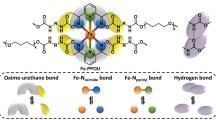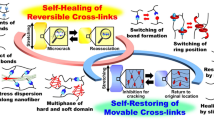Abstract
Self-healing materials can autonomously heal injury like organism, which have attracted increasing attention from academics and industry engineers. However, the mechanical property and self-healing ability of the self-healing material is hard to be reconciled. Here, we report a simple approach to fabricate fast self-healing materials with high mechanical strength and improved triple shape memory effect by incorporation of nanoclay into a polymer matrix. The nanocomposite was prepared by in situ polymerization of poly(ethylene glycol) 400 methyl ether acrylate (mPEG-acrylate) and acryloylmorpholine (ACMO) in the presence of nanoclay. The thus obtained composite exhibits remarkable mechanical properties of an optimistic maximum tensile strength of ~ 8.9 MPa, and high healing efficiency of ~ 99.6% can be achieved after healing for only 1 min at room temperature. This strategy provides insights for the preparation of high-strength, multi-shape memory and fast self-healing composites.
Graphical abstract






Similar content being viewed by others
References
Ha YM, Kim YO, Ahn S, Lee SK, Lee JS, Park M, Chung JW, Jung YC (2019) Robust and stretchable self-healing polyurethane based on polycarbonate diol with different soft-segment molecular weight for flexible devices. Eur Polym J 118:36–44. https://doi.org/10.1016/j.eurpolymj.2019.05.031
Li JP, Yang Y, Chen ZY, Lei S, Shen MK, Zhang T, Lan XK, Qin YJ, Ou-Yang J, Yang XF, Chen Y, Wang ZY, Zhu BP, (2020) Self-healing: a new skill unlocked for ultrasound transducer. Nano Energy. https://doi.org/10.1016/j.nanoen.2019.104348
Yan S, Zhang G, Jiang H, Li F, Zhang L, Xia Y, Wang Z, Wu Y, Li H (2019) Highly stretchable room-temperature self-healing conductors based on wrinkled graphene films for flexible electronics. ACS Appl Mater Interfaces 11:10736–10744. https://doi.org/10.1021/acsami.9b00274
Gao SS, Cheng ZH, Zhou X, Liu YP, Wang JF, Wang CP, Chu FX, Xu F, Zhang DH (2020) Fabrication of lignin based renewable dynamic networks and its applications as self-healing, antifungal and conductive adhesives. Chem Eng J 394:124896. https://doi.org/10.1016/j.cej.2020.124896
Bian W, Wang W, Yang Y (2017) A self-healing and electrical-tree-inhibiting epoxy composite with hydrogen-bonds and SiO(2) particles. Polymers-Basel 9:431. https://doi.org/10.3390/polym9090431
Macedo Lima GR, Orozco F, Picchioni F, Moreno-Villoslada I, Pucci A, Bose RK, Araya-Hermosilla R (2019) Electrically self-healing thermoset MWCNTs composites based on diels-alder and hydrogen bonds. Polymers-Basel 11:1185. https://doi.org/10.3390/polym11111885
Mo SR, Lai JC, Zeng KY, Wang DP, Li CH, Zuo CH (2019) New insights into the mechanical and self-healing properties of polymers cross-linked by Fe(iii)-2,6-pyridinedicarboxamide coordination complexes. Polym Chem-UK 10:362–371. https://doi.org/10.1039/c8py01233d
Tan PS, Somashekar AA, Casari P, Bhattacharyya D (2019) Healing efficiency characterization of self-repairing polymer composites based on damage continuum mechanics. Compos Struct 208:367–376. https://doi.org/10.1016/j.compstruct.2018.09.091
Thangavel G, Tan MWM, Lee PS (2019) Advances in self-healing supramolecular soft materials and nanocomposites. Nano Converg 6:29. https://doi.org/10.1186/s40580-019-0199-9
Cheng Y, Xiao X, Pan K, Pang H (2020) Development and application of self-healing materials in smart batteries and supercapacitors. Chem Eng J 380:122565. https://doi.org/10.1016/j.cej.2019.122565
Kanu NJ, Gupta E, Vates UK, Singh GK (2019) Self-healing composites: a state-of-the-art review. Compos Part A-Appl S 121:474–486. https://doi.org/10.1016/j.compositesa.2019.04.012
Wang Y, Jiang D, Zhang L, Li B, Sun C, Yan H, Wu Z, Liu Z, Zhang Z, Fan J, Hou H, Ding T, Guo Z (2020) Hydrogen bonding derived self-healing polymer composites reinforced with amidation carbon fibers. Nanotechnology 31:025704. https://doi.org/10.1088/1361-6528/ab4743
Menikheim SD, Lavik EB (2020) Self-healing biomaterials: The next generation is nano. Wires Nanomed Nanobi 12:e1641. https://doi.org/10.1002/wnan.1641
Lai JC, Jia XY, Wang DP, Deng YB, Zheng P, Li CH, Zuo JL, Bao Z (2019) Thermodynamically stable whilst kinetically labile coordination bonds lead to strong and tough self-healing polymers. Nat Commun 10:1164. https://doi.org/10.1038/s41467-019-09130-z
Wu DY, Meure S, Solomon D (2008) Self-healing polymeric materials: a review of recent developments. Prog Polym Sci 33:479–522. https://doi.org/10.1016/j.progpolymsci.2008.02.001
Zhang HJ, Sun TL, Zhang AK, Ikura Y, Nakajima T, Nonoyama T, Kurokawa T, Ito O, Ishitobi H, Gong JP (2016) Tough physical double-network hydrogels based on amphiphilic triblock copolymers. Adv Mater 28:4884–4890. https://doi.org/10.1002/adma.201600466
Kim SM, Jeon H, Shin SH, Park SA, Jegal J, Hwang SY, Oh DX, Park J (2018) Superior toughness and fast self-healing at room temperature engineered by transparent elastomers. Adv Mater 30:1705145. https://doi.org/10.1002/adma.201705145
Zhu B, Jasinski N, Benitez A, Noack M, Park D, Goldmann AS, Barner-Kowollik C, Walther A (2015) Hierarchical nacre mimetics with synergistic mechanical properties by control of molecular interactions in self-healing polymers. Angew Chem Int Ed Engl 54:8653–8657. https://doi.org/10.1002/anie.201502323
Cao J, Lu C, Zhuang J, Liu M, Zhang X, Yu Y, Tao Q (2017) Multiple hydrogen bonding enables the self-healing of sensors for human-machine interactions. Angew Chem Int Ed Engl 56:8795–8800. https://doi.org/10.1002/anie.201704217
Chen J, Li FZ, Luo YL, Shi YJ, Ma XF, Zhang M, Boukhvalov DW, Luo ZY (2019) A self-healing elastomer based on an intrinsic non-covalent cross-linking mechanism. J Mater Chem A 7:15207–15214. https://doi.org/10.1039/c9ta03775f
Yanagisawa Y, Nan Y, Okuro K, Aida T (2018) Mechanically robust, readily repairable polymers via tailored noncovalent cross-linking. Science 359:72–76. https://doi.org/10.1126/science.aam7588
Du WN, Jin Y, Shi LJ, Shen YC, Lai SQ, Zhou YT (2020) NIR-light-induced thermoset shape memory polyurethane composites with self-healing and recyclable functionalities. Compos Part B-Eng 195:108092. https://doi.org/10.1016/j.compositesb.2020.108092
Zhai L, Narkar L, Ahn K (2020) Self-healing polymers with nanomaterials and nanostructures. Nano Today 30:100826. https://doi.org/10.1016/j.nantod.2019.100826
Muradyan H, Mozhdehi D, Guan Z (2020) Self-healing magnetic nanocomposites with robust mechanical properties and high magnetic actuation potential prepared from commodity monomers via graft-from approach. Polym Chem 11:1292–1297. https://doi.org/10.1039/c9py01700c
Liu HL, Chung HY (2016) Self-Healing properties of lignin-containing nanocomposite: synthesis of lignin-graft-poly(5-acetylaminopentyl acrylate) via RAFT and click chemistry. Macromolecules 49:7246–7256. https://doi.org/10.1038/s41467-019-10061-y
Parida K, Thangavel G, Cai G, Zhou X, Park S, Xiong J, Lee PS (2019) Extremely stretchable and self-healing conductor based on thermoplastic elastomer for all-three-dimensional printed triboelectric nanogenerator. Nat Commun 10:2158. https://doi.org/10.1038/s41467-019-10061-y
Vijay Kumar V, Balaganesan G, Lee JKY, Neisiany RE, Surendran S, Ramakrishna S (2019) A review of recent advances in nanoengineered polymer composites. Polymers-Basel 11:644. https://doi.org/10.3390/polym11040644
Guadagno L, Vertuccio L, Naddeo C, Calabrese E, Barra G, Raimondo M, Sorrentino A, Binder WH, Michael P, Rana S (2019) Reversible self-healing carbon-based nanocomposites for structural applications. Polymers-Basel 11:903. https://doi.org/10.3390/polym11050903
Guadagno L, Vertuccio L, Naddeo C, Calabrese E, Barra G, Raimondo M, Sorrentino A, Binder WH, Michael P, Rana S (2019) Self-healing epoxy nanocomposites via reversible hydrogen bonding. Compos Part B-Eng 157:1–13. https://doi.org/10.1016/j.compositesb.2018.08.082
Yang SW, Wang S, Du XS, Cheng X, Wang HB, Du ZL (2020) Mechanically and thermo-driven self-healing polyurethane elastomeric composites using inorganic–organic hybrid material as crosslinker. Polym Chem 11:1161–1170. https://doi.org/10.1039/c9py01531k
Liang B, Zhong Z, Jia E, Zhang G, Su Z (2019) Transparent and scratch-resistant antifogging coatings with rapid self-healing capability. ACS Appl Mater Interfaces 11:30300–30307. https://doi.org/10.1021/acsami.9b09610
Wan T, Chen DJ (2018) Preparation of β-cyclodextrin reinforced waterborne polyurethane nanocomposites with excellent mechanical and self-healing property. Compos Sci Technol 168:55–62. https://doi.org/10.1016/j.compscitech.2018.08.049
Amaral AJR, Emamzadeh M, Pasparakis G (2018) Transiently malleable multi-healable hydrogel nanocomposites based on responsive boronic acid copolymers. Polym Chem 9:525–537. https://doi.org/10.1039/c7py01202k
Menon AV, Madras G, Bose S (2019) Mussel-inspired self-healing polyurethane with “flower-like” magnetic MoS2 as efficient microwave absorbers. ACS Appl Polym Mater 1:2417–2429. https://doi.org/10.1021/acsapm.9b00538
Oh CR, Lee SH, Park JH, Lee DS (2019) Thermally self-healing graphene-nanoplate/polyurethane nanocomposites via diels(-)alder reaction through a one-shot process. Nanomaterials (Basel) 9:434. https://doi.org/10.3390/nano9030434
Xu YR, Chen DJ (2017) Self-healing polyurethane/attapulgite nanocomposites based on disulfide bonds and shape memory effect. Mater Chem Phys 195:40–48. https://doi.org/10.1016/j.matchemphys.2017.04.007
Du G, Mao A, Yu J, Hou J, Zhao N, Han J, Zhao Q, Gao W, Xie T, Bai H (2019) Nacre-mimetic composite with intrinsic self-healing and shape-programming capability. Nat Commun 10:800. https://doi.org/10.1038/s41467-019-08643-x
Yu HT, Feng YY, Gao L, Chen C, Zhang ZX, Feng W (2020) Self-healing high strength and thermal conductivity of 3D graphene/PDMS composites by the optimization of multiple molecular interactions. Macromolecules 53:7161–7170. https://doi.org/10.1021/acs.macromol.9b02544
Zhuo SY, Liu YX, Zhou LL, Feng XQ (2018) Enhanced dual-responsive shape memory nanocomposites with rapid and efficient self-healing capability. J Mater Sci 53:13936. https://doi.org/10.1007/s10853-018-2591-y
Yan S, Zhang GZ, Jin XH et al (2018) Rapid room-temperature self-healing conductive nanocomposites based on naturally dried graphene aerogels. Journal of Materials Chemistry C 6:10184. https://doi.org/10.1039/c8tc03692f
Wang C, Liu N, Allen R, Tok JB, Wu Y, Zhang F, Chen Y, Bao Z (2013) A rapid and efficient self-healing thermo-reversible elastomer crosslinked with graphene oxide. Adv Mater 25:5785–5790. https://doi.org/10.1002/adma.201302962
Feng XQ, Zhang GZ, Zhuo SY, Jiang HY, Shi JL, Li FB, Li HJ (2016) Dual responsive shape memory polymer/clay nanocomposites. Compos Sci Technol 129:53–60. https://doi.org/10.1016/j.compscitech.2016.04.008
Zhao WP, Liu YY, Zhang ZX, Feng XQ, Xu H, Xu J, Hu J, Wang SG, Wu YM, Yan SK (2020) High-strength, fast self-healing, aging-insensitive elastomers with shape memory effect. ACS Appl Mater Interfaces 12:35445–35452. https://doi.org/10.1021/acsami.0c09045
PerovaTS VJK, Xu H (1997) Fourier transform infrared study of poly (2-hydroxyethyl methacrylate) PHEMA. Colloid Polym Sci 275:323–332. https://doi.org/10.1007/s003960050089
Jasiurkowska-Delaporte M, Kossack W, Kipnusu WK, Sangoro JR, Iacob C, Kremer F (2018) Glassy dynamics of two poly(ethylene glycol) derivatives in the bulk and in nanometric confinement as reflected in its inter- and intra-molecular interactions. J Chem Phys. https://doi.org/10.1063/1.5039518
Ogundiran MB, Kumar S (2015) Synthesis and characterisation of geopolymer from Nigerian Clay. Appl Clay Sci 108:173–181. https://doi.org/10.1016/j.clay.2015.02.022
Lu CW, Ling Z, Wang CP, Wang JF, Yong Q, Chu FX (2022) Multiple hydrogen bonding interactions toward rapidly self-healing, photothermal conversion elastomer composites. Compos Part B Eng 4:3. https://doi.org/10.1016/j.compositesb.2021.109428
Acknowledgements
The authors thank the Key Natural Science Foundation of YIT (2020YITSRFZD101) and the Key Science and Technology Project of Hebei Education Department (ZD2019301).
Author information
Authors and Affiliations
Contributions
JX was responsible for conceptualization, investigation, data curation, visualization, writing the original draft, and writing, reviewing and editing. Z-XZ was involved in investigation, formal analysis and visualization. Y-JN, Y-XL and YF carried out investigation. W-PZ took part in formal analysis, writing the original draft, resources, supervision and funding acquisition. X-qF participated in validation, data curation, writing the original draft, conceptualization, validation, writing, reviewing and editing, project administration and funding acquisition.
Corresponding authors
Ethics declarations
Conflicts of interest
The authors declare that they have no known competing financial interests or personal relationships that could have appeared to influence the work reported in this paper.
Additional information
Handling Editor: Jaime Grunlan.
Publisher's Note
Springer Nature remains neutral with regard to jurisdictional claims in published maps and institutional affiliations.
Supplementary Information
Below is the link to the electronic supplementary material.
Supplementary file2 (MP4 50656 kb)
Rights and permissions
About this article
Cite this article
Xu, J., Zhang, Z., Nie, Y. et al. Dual physical cross-linked self-healing elastomer for the triple shape memory. J Mater Sci 57, 11430–11442 (2022). https://doi.org/10.1007/s10853-022-07243-3
Received:
Accepted:
Published:
Issue Date:
DOI: https://doi.org/10.1007/s10853-022-07243-3




